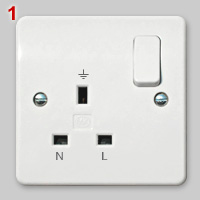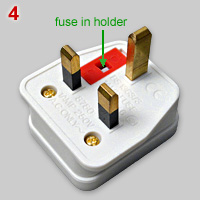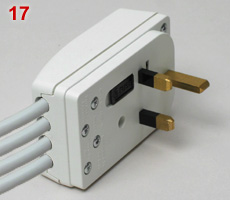 |
BS 1363 British plugs and sockets |
|
British
standard plugs and sockets according to BS 1363 are introduced in the
late 1940s. Used in the UK, Ireland, Cyprus, Malta
and some countries in Africa and Asia.
Background information about the origin of BS 1363 is given below. Information on the history of British domestic plugs in general is given on a separate page. Logos and notes on history of manufacturers of material shown on BS1363 plugs and socket pages are given on another separate page. |
 |
Related
galleries: uncommon types classic types Wylex plugs Dorman & Smith plugs Fitall 5 in 1 plug Folding plugs fused connection units |
|
|
|
|
|
 |
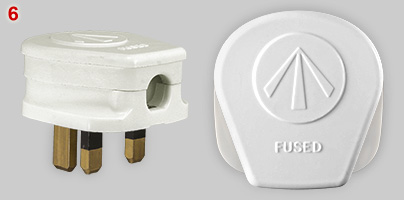 |
 |
| 1 | BS
1363
socket. The
neutral and line slots are protected by shutters, which are opened by
insertion of the longer earth pin. The BS 1363 plug and socket
combination is considered a very safe system. It is mandatory that
access to line and neutral contacts is protected by safety shutters
(details are shown below). Most wall sockets
have
built-in switches, reducing the need for plug removal when power is not
required. The switch is just for convenience, and is not a regulatory
requirement. Manufacturer: MK Electric. |
| 2 | BS 1363
plug. From
1984 line and neutral pins must have insulating sleeves (black
sheaths)
to minimize
the risk of a shock when pushing the plug in. Insulating sleeves are
not allowed for earth pins. These
plugs always have a side entry cable, rather than top entry. This
feature makes it difficult to unplug it by tugging on the cable, which
is an unsafe practice. Manufacturer: MK Electric. |
| 3 | Inside
view of a
typical BS 1363 plug. Because British circuits (see page on ring circuits)
can deliver more current than many appliance power cords can safely
handle, BS 1363 plugs are required to carry a BS 1362
cartridge fuse. Existing BS 1362 fuse ratings are: 13, 10, 7, 5, 3, 2
and 1A
ampere. 13A is commonly used in BS 1363 plugs (hence also indicated as
'13A plug' ). MK plugs have an automatic cordgrip. The angled cordgrips secures a cord when attempting to withdraw the cord. Note the position of screws to fix wires. The shortest wire is connected to the line terminal, the next longest to neutral and the longest wire to the earth pin (see image). Therefore, should the cord grip fail to do it's job., the first wire to come loose is the brown line, followed by blue-neutral and lastly earth. A safe procedure. |
| 4 | Usually
you have to
unscrew a BS 1363 plug for replacing the fuse. For moulded plugs and
devices that cannot be unscrewed - such as adapter and (some) multi
plugs - the fuse is accessible from the outside of the plug. The
example shown is a 'shavers only' adapter (see no. 15). Manufacturer:
PMS Electrical Manufactury Ltd in Singapore. |
| 5 | Duplex BS
1363
socket with
Residual Current Device (RCD), a safety feature that evaluates the
current difference between line and neutral and interrupts the flow of
electricity when a sudden difference is measured. The RCD socket
complies with BS 7288 (1990). The rated trip current is 30mA; break
time is less than 40 msec. Manufacturer: Smiths (England).
{JM} |
| 6 |
Plug
that is not for sale, although it has the same shape, functionality and
manufacturer (MK electric) as plug no. 2. The broad arrow (image right) shows the distinctive difference between plug nos 2 and 6. The symbol is used to indicate British government property, in particular War Department, later Ministry of Defense. A collectors item that has to be shown. {MH} |
| 7a | Plug manufactured by MK Electric for using by the British Broadcasting Corporation only. Dating: mid 1980s. Plug is not an item of the museum collection. Image is based on a photo taken by Ian Allen. The museum is grateful for allowing to include the image to the website. |
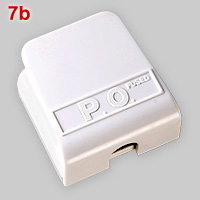 |
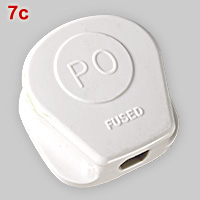 |
 |
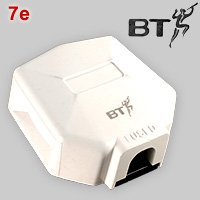 |
| Examples
of standard 13A plugs that were supplied with Post Office and
British Telecom equipment used by customers. Each of the four plugs have partially insulated line and neutral pins. On plug no. 7b it is indicated that patent 1181370 - "Improvements in the Pins of electric Plugs" granted to Eric James Butcher and Walter Henry Thompson of J.A. Crabtree Ltd. - applies to insulating pin sleeves. Date of patent publication: 18 Feb. 1970 (Espacenet link). Right: patent images (edited): Fig.1, plug with insulated line and neutral pin; Fig.2, cross section of pin with shallow groove filled with insulated material. |
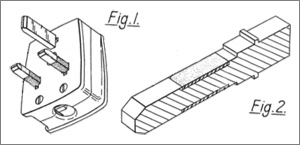 |
| 7b, c |
Post Office Telephones dept. could have
been used 'PO plugs' for connection apparatuses as switchboards,
internet
routers etc. Manufacturer of plug 7b: Marbo, tradename of Marbourn Ltd. {DCN} Manufacturer of plug 7c: MK Electric. {DCN} |
| 7d 7e |
MK Electric plug with British Telecom (BT)
logo used from 1980 until 1991 {DCN}. Duraplast Electricals Ltd. plug with BT logo used from 1991 until 2003. The logo shows a running man with pipe, designed by Wolff Olins. The running man was supposed to represent the mythical Pan the messenger. {DF} |
 |
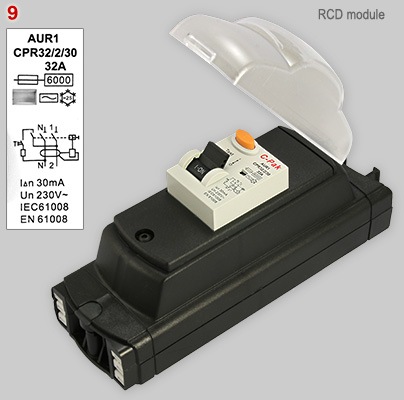 |
   |
| 8 | Rotasoc modular desk power system. The
shown system consists
of a rewirable in-feed module (to be connected to mains), a RCD
(Residual Current Device) module, a 4 gang
socket module (2 and 3 gang are also available), and end cap. Other modules that are available are among others: in-feed module with master switch, interconnection modules to add another socket module (a flex cord connects male and female couplers) and data modules (HDMI, USB or phone). The four white outlets have a standard earth connection. Clean earth is available also (outlets are red). Rating: max load 32A - 250V. Rotasoc is a registered trademark of Electrak. {MH} Manufacturers: Electrac (modules 1, 3 and 4), and CMD-Ltd (module 2). |
| 9 | Module with 32A / 30mA - 230V residual
current operated circuit breaker with on-off switch (black) and test
button (orange). |
| 10 | Modules
lock together by cam-lock lever. The image shows the cam in lock
position. To unlock, a lever rotates cam in upright position. Lever -
not visible - is situated in the bottom part of the module. The same locking mechanism applies to each modules and end cap. |
| 11 | Socket outlets rotate 360 degrees. Each outlet has a pattern of dots indicating the position in the sequence of outlets. |
| 12 | Each socket outlet has a 5A fuse,
necessary according to BS 6396 (about electrical equipment within
general office furniture). |
 |
|
 |
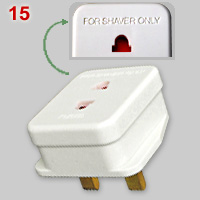 |
 |
|
|
|
| 13 |
Cable couplers with orange rubber housing. The plug has a label that stated 'Not intended for domestic use / Industrial use only / Do not use in standard outlet' (however, plug fits without any problem in a standard, domestic socket). Couplers are also available in black rubber design. Manufacturer: Haffenden - Richbotough Ltd, Sandwich, Kent, England; information leaflet mention: Duraplug Electricals Ltd. {FSE} |
| 14 | Two examples of BS 1363 folding plugs. Top: Slimplug; bottom: Thinplug. Details are given on a separate page. |
| 15 | Adapter
for shavers,
equipped with a 1A BS 646* fuse. Shavers only adapters can be used
for British shaver plugs (BS 4573), Europlugs and US 15A flat
blade plugs. Note that the adapter
plug does not have a
transformer (no 120V for US shavers!). * BS 646 fuses are smaller than standard BS 1362 fuses (19.1 mm versus 25.4 mm). More details and images of shaver sockets and plugs are given on the BS 4573 page. |
| 16 | 3-way
multi-plug (also known as multi-way portable socket).
Also multi plugs are fused to ensure that the maximum load does not
exceed 13A. Manufacturer: PMS. |
| 17 | Multiway mains plug that allows four appliances to be plugged into one socket outlet. According to the documentation provided: the device is ideal when multiples of electrical appliances are used together without the need to switch them individually on or off. The fused (13A) plug conforms to BS 5733. Brand name: Incept. |
| 18 | Multi-connector, equipped with four mini-plugs (BS 5733). The load of each mini-plug should not exceed 6A. The total load of the multi-connector is restricted to 13A, because of the BS 1363 mains plug. The block includes two mounting holes for wall fitting and is provided with an on/off indicator light. Brand name: Micromark. |
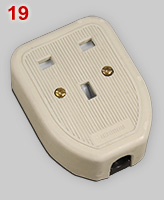 |
 |
 |
 |
 |
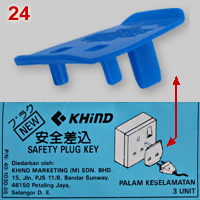 |
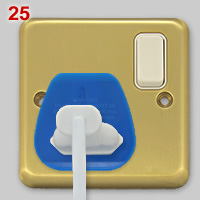 |
| 19 |
Connector with rubber cap, for an extension cord. Rating: 13A - 250V. The connector has been used to show the safety shutter mecanism of BS 1363 sockets and connectors. Manufacturer: Dencon Accessories Lts, Harlow, Essex, England. |
| 20, 21 |
BS
1363 sockets and connectors have to be provided with shutters that
cover line and neutral contacts. Shutters prevent the
insertion of any object other than a BS 1363 standard plug. Image no. 20 shows connector no. 19 after removing the rubber cap. A white plastic shutter covers L and N contacts. Image 21 shows that the earth pin - on purpose the longest pin of a BS 1363 plug - pushes the shutter aside and L and N contacts become accessible for the power pins. The system to open shutters by moving down the earth pin is the most common method on UK plugs. Other methods, used on various types of plugs are shown on the socket safety shutters page. |
| 22 | BS
1363 plug inserted into connector no. 19. The earth slot is positioned ca. 3 cm (1.2")
away from the
edge of the connector housing. Insertion an inverted
plug is not possible and safety shutters remain closed. Opening
shutters of a surface mount socket (see nos 1 and 5) by an inverted
plugs is also impossible. |
| 23 | Example
of an surface mount socket that dates back to the 1950s. It is possible
to insert an inverted plug fully. Safety shutters are pushed away and a
live contact can be touched by a foreign object. A potential dangerous
situation when the switch is on. BS 1363:2016 still allows socket sizes that permit shutter opening by an inverted plug. It explains that shutters of Rotasoc outlets can be pushed away by an inverted plug, if the earth contact is in a fully up or down position (see image no 11-right). The same applies to the top-outlet of multi-plug no. 16. |
| 24, 25 |
Plug
key, made in
Malaysia. A cheap alternative to the Europlug converter (shown in image
nos 27-29. The large -
plastic - earth pin pushes aside the safety shutter of line and neutral
contacts. The two smaller pins keeps the key
in position. Using plug keys is dangerous if the 2-pin plug is removed, but the key remains. Line and neutral contacts are no longer protected. Therefore the use of plug keys is not allowed in the UK and Ireland. Read more about possible hazards at http://www.fatallyflawed.org.uk/ website. |
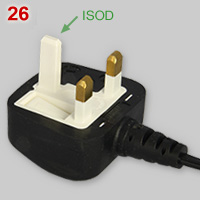 |
 |
 |
 |
| 26 | Fully approved BS 1363 plug without earth connection. The replacement plastic pin - known as ISOD = Insulated Shutter Opening Device - is necessary to open the safety shutters of a BS 1363 socket. It also ensures that the plug remains polarized, i.e line and neutral keep their unique positions. The example shows the supply end of a power cord with moulded plugs. The other end has a 2-pole C7 type IEC 60320 connector. Manufacturer: Volex {PO} |
| 27 - 29 |
BS
1363 sockets must have shutters that cover line and neutral contacts.
Moreover it shall not be possible to operate a shutter by inserting a
2-pin plug into a 3-pin socket. A special
converter has been designed, making not earthed Europlugs
accessible to BS 1363 outlets. They comply with BS 5733. Since Europlugs are rated for 2.5A the converter has a 3A BS 1362 fuse. Image no. 28 shows the converter with Europlug inserted. With closed lid the plug cannot be removed. The lid can be secured with a standard or tamper resistant screw. Only genuine CEE 7/16 plugs fit in this converter. Manufacturer: Powerconnections, Bicester, Oxon, England. |
Note. Comparable converters exist for US NEMA 1-15 (2-pin) and 5-15 (3-pin) plugs and Italian CEI 23-50, 3-pin 10A plugs. Converter plugs for NEMA 5-15 and Italian plugs have a fully functional earth pin, rather than a plastic replacement pin (ISOD). |
| About
BS 1363 In 1941 committees were established to investigate problems likely to affect the post-war rebuilding of Britain. The Electrical Installation Committee was charged in 1942 with the study off all aspects of electrical installations in buildings. Their report, that appeared in 1944, states among others: "Experience has shown that the present three standard sizes of three-pin socket-outlets and plugs suitable for domestic use (BS 546), rated respectively at 2, 5, and 15 amperes, have not been wholly satisfactory from the standpoint of the convenience of the consumer. The absence of an intermediate size between 5 and 15 amperes, and the cost and dimensions of the 15-ampere standard, have contributed to the use of non-standard socket-outlets and plugs to fill a gap in which there is a substantial demand." The committee proposed that a completely new socket-outlet and plug should be adopted as the "all-purpose" domestic standard. Safety aspects were an important issue. Among others, to ensure the safety of young children, socket contacts should be protected by shutters or other like means. Another recommendation was to introduce a ring circuit wiring system, that offered a more efficient and lower cost system which would safely support a greater number of sockets. In contrast to conventional radial wiring, ring wiring requires fused plugs; see radial and ring circuit page for details. In 1947 BS 1363 became the new standard for "Fused-Plugs and Shuttered Socket-Outlets". MK Electric and at least two other companies, Wylex and Dorman & Smith, have designed fused plugs. The MK 13A plug design became the dominant BS 1363 type. Wylex and Dorman & Smith designs disappeared gradually in the late 20st century. From late 1940s new houses are wired according to ring circuit system. Some older houses were rewired, others existing installations were given a face lift by replacing the wall-sockets. New applications are supplied with a fused BS 1363 plug. The MK type of plug, with rectangular pins finally became - de facto - the standard BS 1363 plug. Wylex and Dorman & Smith plugs and sockets have been used up to the late 1980s. BS 546 plugs and sockets are still used in the U.K. and Ireland. Among others for centrally switched lighting circuits, in order to distinguish them from normal power circuits. Some countries of the Commonwealth of Nations still use BS 546, others have adopted BS 1363, and occasionally a mix of "old" and "new" can be found. Note that also fused BS 546 plugs exist, see BS 546 page. Main sources of information are: personal communication by David Peacock (see also The Remarkable Evolution of BS 1363 in Wiring Matters issue 49 - winter 2013) and Wikipedia page on British AC power plugs and sockets. |
|
|
|
|
|
|
